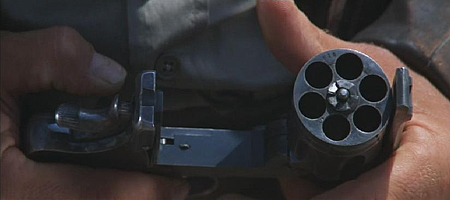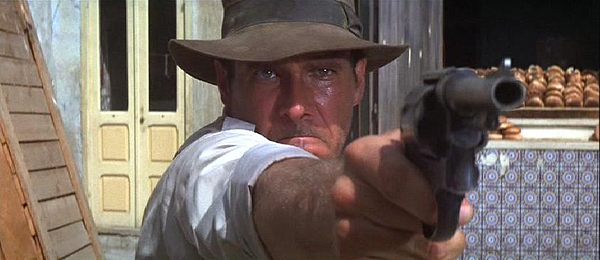
The guns Indiana Jones uses in the course of the film series vary from film to film, and in the case of Raiders, sometimes scene to scene, but every pistol Indiana Jones uses is indicative of the post-World War I era. All of his sidearms are early-1900s military designs and although there are a few choice moments in Raiders of the Lost Ark where he uses a semi-automatic, Indiana Jones is most often identified with the revolver.
The use of the revolver hearkens back to the Western heroes and their Colt peacemakers, a genre that helped inspire the Indiana Jones series. Until World War II, revolvers were the mainstay sidearm in most military units throughout the world and remained the sidearms of choice for police forces throughout the world well into the 1980s.
Smith and Wesson became famous for making revolvers in the 1800s, and the “hand ejector” may be considered the first “modern” style revolver. They were popular with the military in the late 1800s, early 1900s, because they could be quickly emptied and reloaded.
RAIDERS OF THE LOST ARK
There were two primary revolvers used in Raiders of the Lost Ark. One was a Smith & Wesson 1917, chambered for .45 ACP from Stembridge rentals in Hollywood. The second was a Smith & Wesson Hand Ejector Model 2 (HE2) from Bapty & Co. in London. It is widely accepted that the Bapty was used in all the revolver shooting scenes.
Both guns had their barrels cut down to four inches. A distinguishing feature in recognizing one of these type guns is the slim profile checkered grips. A variant in the two Raiders hand ejectors was the S&W gold medallions inlaid in the grips. The .455 had them and the .45 ACP did not. This can most likely be attributed to an oversight in production.
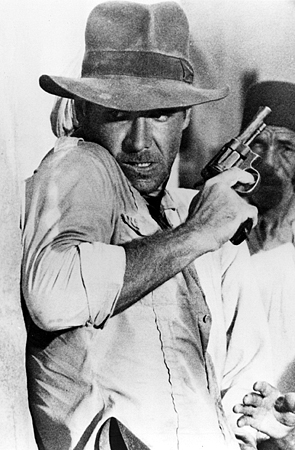
Both of these pistols were sold at separate auctions a few years ago and are now in private hands, with both owners kind enough to provide details on these now-historically important revolvers.
The Smith and Wesson Hand Ejector 2nd Model “Bapty”
The “Bapty” was a Hand Ejector 2nd Model with lanyard ring and a 4-inch barrel with a “Baughman-style” front ramp sight and worn blued finish. The revolver is also clearly in the .455 Eley caliber as because exposed brass cannot be seen at the back of the revolver’s cylinder during the film.
Thanks to careful research by “Indy45,” who will be quoted in the following descriptions, much is now known about the “Bapty,” including even the smallest details.
The barrel on the “Bapty” is likely a later barrel added to the gun as there were no HE2s made with 4-inch barrels.
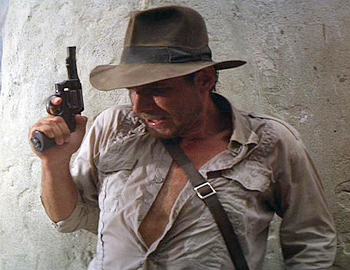
“A S&W 1917 muzzle wall thickness measures about .090, while the movie gun looks like .060-.070. I was able to verify on Smith-WessonForum.com that the later S&W 1950 Army and Model 22 (through 1966) had thinner walls, so Bapty cutting and installing a later barrel would explain the difference.”
When the gun was photographed after auction, it was learned that the pistol was indeed a British contract revolver.
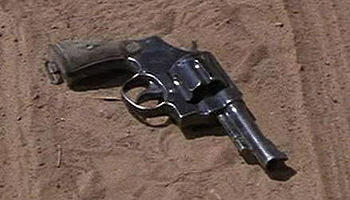
Through photographic analysis, it was learned that the “Bapty” is one of the English WWI contract guns in the s/n range 5001 to 74755 and re-blued “to cover the barrel work.” The gun used .455 blanks, available since the 1930’s.
The front sight, custom made from steel stock, measures 9mm (.355 inches) high, 6mm (.236 inches) wide and 2.8 cm (1.10 inches) long. The blade ramp is about .162 inches high, .086 inches wide and .537 inches long, with serrations on it’s angled surface. The sight base top is .724 inches long before it slopes off to the barrel.
“The overall finish is worn with rust specs with “dings”, or dents, on either side of the barrel near the frame, probably from placing the barrel in a vise, and at the flare where the cylinder pin hits the frame when closing the cylinder.”
Also of note is a crossed flag British proof on the frame left side at the barrel centerline and on the right side of the frame, the S&W “Trade Mark” circular logo. Patent text on the top side of the barrel is partially covered by the front sight. The barrel left side printing says “SMITH & WESSON .455.”
“All numbers on steel match the S/N 39871 except the cylinder, which means the cylinder was probably replaced long ago by Bapty. The grips are well worn checkered walnut with the gold (brass) S&W indented logo. Unknown if the right grip has the S/N penciled on the underside.”
When sold at auction, the Bapty Raiders revolver was officially deactivated to be sold in compliance with current British laws. The ejector was removed and the cylinder counter-bored so a cartridge block could be welded in place. The ejector no longer functions and likely a barrel block was installed “as there looks to be a drilled and filled hole on the underside of the very front of the barrel.”

The Smith and Wesson 1917 “Stembridge”
As previously stated, there are two different revolvers in Raiders of the Lost Ark. The “Bapty” fired the blanks. The second, most notably seen when Indiana Jones cavalierly tosses it into his suitcase in his home, is a revolver that the production team rented from Stembridge Gun Rentals of Glendale, CA. The “Stembridge” was also used in the beginning of the movie during the Chachapoyan temple scene in Peru, filmed in Hawaii, when Indiana Jones relinquishes his gun to Belloq. This revolver is noteworthy for it’s banded barrel sight and a corner missing from the left grip bottom front, exposing part of the butt frame.
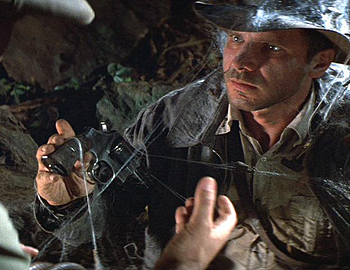
Thanks to meticulous research by Lee Keppler, Indy45, Indiana Bond and others, the history of the “Stembridge” is well documented. Keppler was able to rent the Raiders “Stembridge” in 1985, long before it was sold at public auction in 2007. He took detailed photos of it at the time, and the new owner was kind enough to provide additional photos and information after the sale.
The “Stembridge” is a Smith & Wesson Hand Ejector 2nd Model with a blued finish, lanyard ring and the normal 1917 5.5-inch barrel cut down to 4 inches. The first half-inch of the barrel is a band sweated over a turned down barrel. The band is not the reamed out section of the front of the cut off barrel as there is no taper to the band. The front sight is re-shaped and silver soldered to a flattened area on the band.
The “Stembridge” is a Commercial Model, as evidenced by the small circle S&W “Trade Mark” logo on the left side of the frame under the cylinder release and was chambered for .45 ACP. The grips were checkered walnut with no medallions and rounded at the top. Although the grips sometimes appear black on film, the grips were actually very dark brown as they were “well oiled.” Incidentally, the ejector rod locking lug pin was actually missing on the “Stembridge.”
The serial number was 172449. The barrel’s left side states “S.&W. D.A.45.” The barrel’s right side states “SMITH & WESSON.” The top of the barrel has two lines of fine print, but since the barrel was cut and the front blade re-attached with a band, the remaining visible lettering is “WESSON SPRINGFIELD MASS. U.S.A. DEC. 17 1901 FEB 6 1906 SEP.14 1909”.
The Smith & Wesson 1917 has an interesting history. S&W designed their big N Frame revolver in .44 caliber in 1908. The British Government placed a large order for about 75,000 chambered in .455 Mk II (Webley) in 1914. One of these, a Hand Ejector Model 2, turned out to be the “Bapty” shooter. At the start of World War I, Colt could not produce sufficient numbers of their 1911 .45 ACP automatic to meet U.S. Government requirements, so the U.S. asked S&W to supply large frame revolvers in .45 ACP. Since .45 ACP is rimless, the revolver’s chambers were designed with an inner lip so that the cartridge would rest or “headspace” at the proper depth. But once fired, the brass was difficult to extract, as the hand-ejector had nothing to grab. S&W is credited with designing a half-moon clip that in effect provided a ‘rim’ for the cartridges and made loading and unloading easier.
The U.S. Government contracted with S&W for the .45 ACP U.S. Service Model of 1917, with production totaling about 163,000. The 1917s have 5.5-inch barrels, and nearly all are blued finish, although some World War II armory re-furbishes have a parkerized finish. About 25,000 1917s were also produced for the Brazilian Government in 1938. S&W continued production of the 1917 in a U.S. Commercial version after February 1, 1919 until 1946. The “Stembridge” was one of the Commercial 1917s, rare in terms of production numbers, with only about 20,000 made.
The Browning Hi-Power—The Raiders Backup Weapon
Raiders of the Lost Ark is the only film in which Indy carries two pistols. For years, exactly where he kept the second one throughout the film was unknown and a source of much conjecture. But with 2023 the release of Timeless Heroes: Indiana Jones and Harrison Ford, we learned that Indy kept it in a shoulder holster.
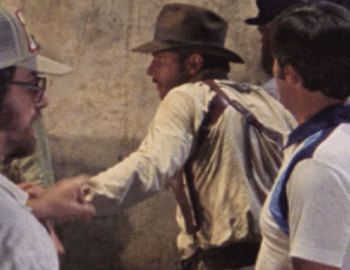
Indy’s alternate handgun in Raiders was the Browning Hi-Power (HP). The Hi-Power variant we see Indy use on screen is a Canadian made Inglis. It differs from the regular HP in that the rear sight is slightly larger and has a “hump” shape. This pistol can first be seen in the Ravenwood Bar scene and later just before Katanga’s ship is boarded. Like its cousin the Colt M1911, the Browning HP may be regarded as one of the most successful semi-automatic pistol designs ever produced. Not only is it still in service in large numbers, but it also has been produced at many locations in many countries. It was one of the last weapon designs produced by John Browning before his death in 1925, but it was not until 1935 that the HP was placed in production by FN at Liege, Belgium.
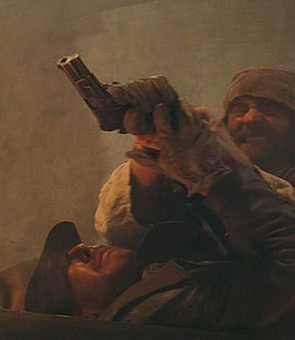
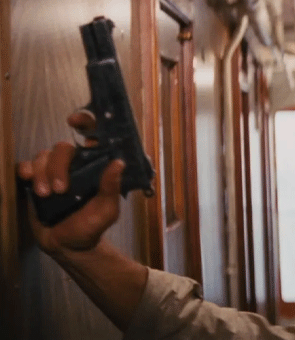
Within a few years of the start of production, the Browning HP had been adopted as the service pistol of several nations including Belgium, Denmark, Lithuania, and Romania. After 1940, when World War II broke out, the Belgium FN factory continued production at full capacity and produced approximately two hundred thousand pistols under Nazi occupation for the Germans, who adopted the type as the standard pistol of the Waffen-SS. These pistols were known to be subject to sabotage during manufacturing. Since introduction, FN has produced well over 1.5 million Hi-Powers, but any Hi-Power bearing Nazi proof marks must be closely examined by a competent gunsmith to determine its serviceability prior to firing. Numerous versions may be encountered, but they all fire the standard 9mm Parabellum cartridge, except for some recent models in .40 S&W.
It is said that this gun is preferred by the movie industry and may have been used in the filming of Raiders as a stand-in for a .45 because 9mm blanks are more reliable than those of .45 caliber, resulting in fewer re-takes.
The debate of Indy’s automatic gun has lasted for years. It was believed to be the Colt .45, until recent discussions & evidence have concluded that it was rather, the Browning High Power.
INDIANA JONES AND THE TEMPLE OF DOOM
Indy does not actually carry a handgun through most of of his second screen adventure as he loses his gun near the beginning of the film. For the short time that he does have a handgun—using it in the car chase after escaping Club Obi Wan—we actually see two different guns during this scene, with the second one being a “stunt double”. For many years it was thought that the handgun used by Indy and then fumbled by Willie Scott was the Smith & Wesson (S&W) .455 Hand Ejector 2 that had been used in Raiders of the Lost Ark. The second “stunt double” gun seen falling out of the car was thought to have been a fake rubber Colt New Service M1917 “stunt” gun. It has now been proven through extensive research done in 2009 and through new evidence provided by the prop company that rented the firearms for the filming, that neither of these guns were used in the film.
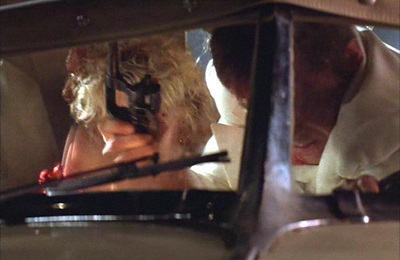
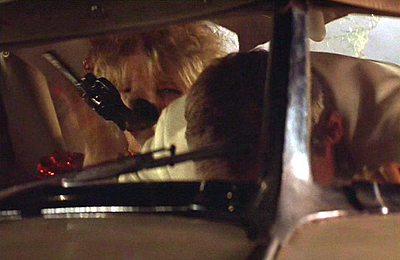
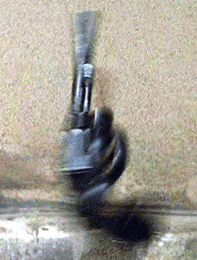

Information provided by the Hollywood prop company shows that there were only 3 handguns rented for the filming of Temple of Doom. A Colt .38 “Official Police ” with a four inch barrel, a S&W .38 with a five inch barrel and lanyard ring, and a third gun that was not used in the filming (but we will discuss later). Since these were the only guns rented to the film company it would have been impossible that the “Raiders” S&W Hand Ejector or a Colt M1917 could have been used. With this information in hand and to determine which revolver was actually used, an extensive photographic research campaign was conducted comparing screen grabs and photos of a four inch Colt “Official Police’” and a five inch S&W .38. Through this extensive research it was concluded that the handgun used by Indy and fumbled by Willy Scott was the four inch Colt OP and the handgun we see falling out of the car was the five inch S&W .38.
The major identifying differences between the Colt and the S&W are:
• Barrel length—Colt 4 inch and the S&W 5 inch.
• Ejector shroud—Colt has none and the S&W does have one.
• Grip medallion—Colt has a silver medallion and the S&W has no medallion.
• Lanyard ring—Colt does not have one and the S&W does.
The photographic comparison research shows that the handgun being fumbled by Willy does not have a lanyard ring or an ejector shroud, but does have grip medallions. This can be seen in the photos. Furthermore a photographic comparison of barrel lengths shows that it had a four inch barrel and not the longer five inch barrel. This evidence proves it to be the four inch Colt “Official Police”.
Photographic comparisons of the handgun falling out of the car shows both a lanyard ring and a barrel shroud, no medallion, and a longer barrel. These attributes can also be seen in the photos thus point this to being the five inch S&W .38.
Both the Colt “Official Police” and the S&W .38 revolvers were very popular guns of the period. Both were used by thousands of military, police and civilians. Both these handguns were in production for decades and even now modern day versions are still being produced and used.
Now an interesting note about the third gun that was rented for filming but never used. According to the Hollywood prop house records the third gun rented was a Webley Green! That’s right, the same gun we see Indy using in The Last Crusade and The Kingdom of the Crystal Skull. The records show that the Webley Green was marked as the “Hero” gun thus was the gun that Indy was supposed to have used and then lost. This does make sense as throughout the rest of the film we see that Indy’s holster is a large Webley Green holster. Why would Indy be wearing a large Webley style holster if he wasn’t supposed to have a Webley Green?
So why was the smaller Colt “Official Police” used instead of the Webley. There is much speculation on this. Perhaps the film crew made a mistake and used the wrong handgun. Perhaps the Webley Green was too big for Willy Scott to handle and “fumble” easily so they decided to substitute the smaller Colt OP. We may never know!
INDIANA JONES AND THE LAST CRUSADE / INDIANA JONES AND THE KINGDOM OF THE CRYSTAL SKULL
The Webley Green
For many years, it was almost considered fact that Indiana Jones’ sidearm in Last Crusade was the venerable Webley Mark VI revolver, a legendary pistol used by British troops throughout World War I and ultimately seeing combat in World War II as well. The pistol also plays a prominent role in the film, Lawrence of Arabia.
However, relatively recent discoveries, thanks to the clarity of DVD images, have revealed that the pistol is actually the more rare Webley Green. The Webley Green is marginally larger than the Mark VI and has a distinctive “bird’s head” grip that distinguishes it from the Mark VI, which has a squared off grip. It is a heavy hinged frame gun, originally issued in .455 caliber.
Thanks to Webley Green owner and IndyGear member Rook, Indiana Jones’ Webley Green is known to be a later manufactured example.
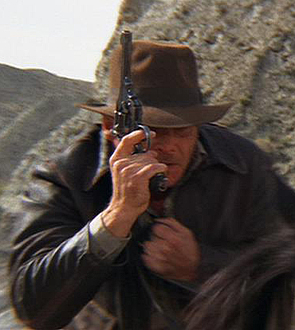
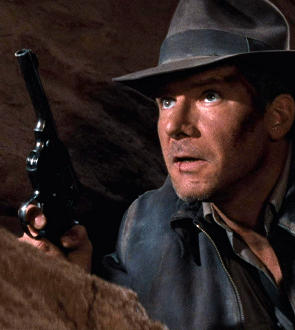
“Indy’s version is a later manufacture. The serial number is, I believe, around 11,000. There are design similarities with the Webley Mark III, and some small parts are interchangeable between them. My pistol says ‘WG’ ARMY Model and is chambered for .455/.476. The cylinder is slightly longer than the standard .455 cylinder found on the Webley Mark VI, so the cylinders are not [interchangeable] between these pistols. The most noticeable differences between the Mark VI and the WG are the pronounced bird’s head grip and the longer grip frame with extra space in front of the trigger guard, although I have also seen WG’s with a flat bottom, ‘cowboy’ style grip. Also, unlike the Mark VI and Mark IV, the WG trigger guard is integrated with the grip frame and is not bolted into place nor removable.”
The Webley Green was supposedly manufactured from 1885 to 1912, with some models chambered for the .450/.455 “Mark I” cartridge while others, including Indy’s, were chambered for the .455/.475 Mark II cartridge. Many firearms dealers refer to the Webley Green as a ‘Webley 1896 W.G. Army Revolver.’
“Serial numbers, as far as I can tell, offer no clue as to when pistols manufactured and were chambered for what round. I’ve seen “1896” pistols chambered in .450/.455 with serial numbers as high as 21,000!”
